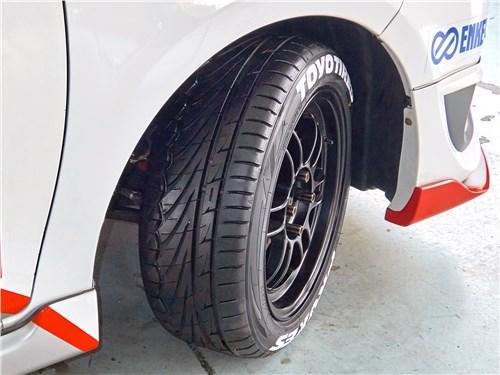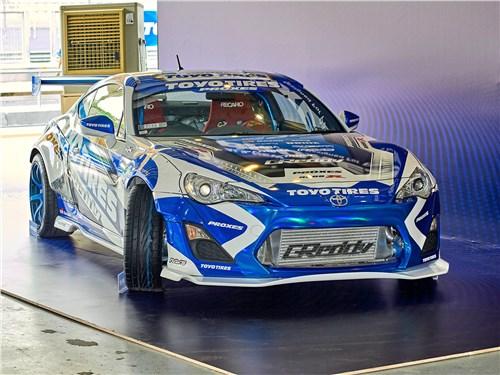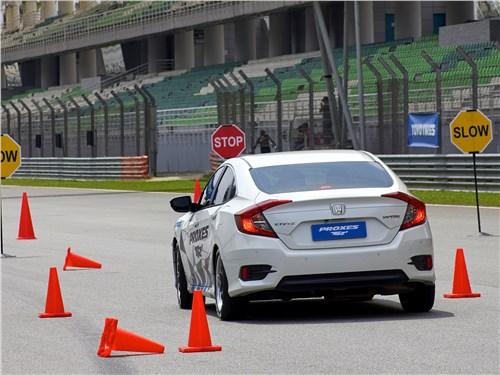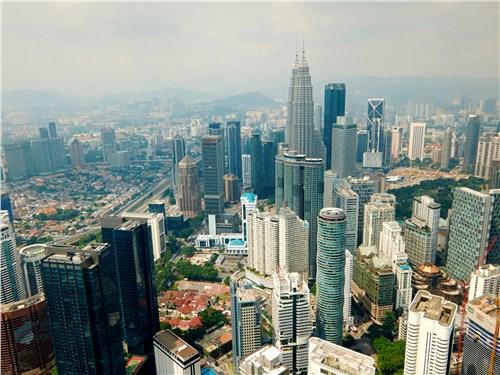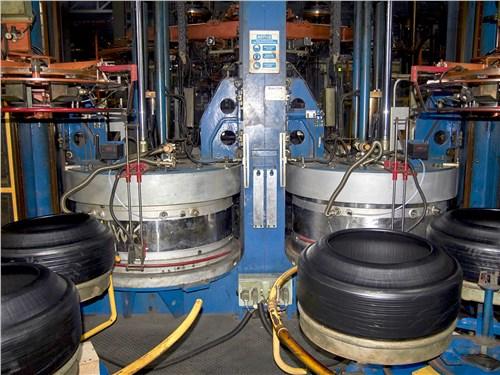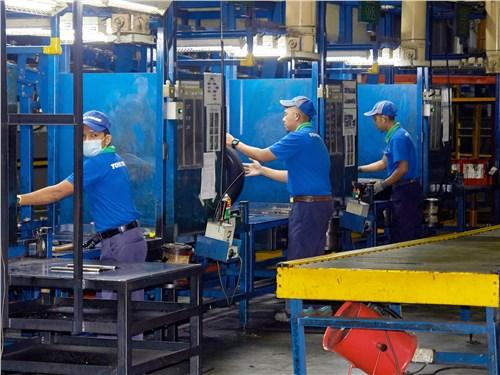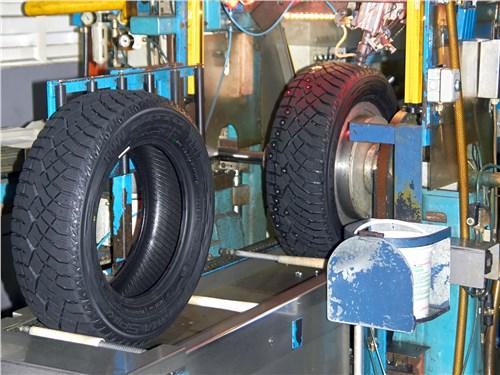Toyo Tires: A.T.O.M. World
The exterior design of Toyo Proxes TP1 in its segment is no less important than its driving properties.
"Fight" the famous Japanese racer Masato Kawabata
View of Kuala Lumpur, the capital of Malaysia, from the observation deck of the tower
In a few minutes, blanks will turn into winter tires
Final control is entrusted only to the most experienced employees
Forward Line-Shipovka works with "local" Tires and rubber from adjacent plants
Plant President and Managing Director Mike Toh combines attention to detail with Asian European democracy
What do the warmth of Malaysia and the cold Russian winter have in common? Which tire not only handles well, but also looks extremely impressive? And why rubber "bombardment" with electrons? This is our Japanese company Toyo, inviting in a distant Asian country
Sepang International Circuit, located near the capital of Malaysia, was buzzing that day, woke up not on the engines of Formula 1 cars, and a motley crowd of journalists and tire dealers who were invited to the presentation of the new Toyo Proxes TP1 tire. To be precise, the tire premiered last year at the 2018 Essen Motor Show, but now it’s got a special big event with a dedicated track, tall, leggy (by local standards) models, and a glamorous demeanor, and a piercing voice.
President and CEO of the Malaysian division of Tang song Chai LLP from the podium described the situation of the new tire in the company’s lineup and its target audience: according to him, the model will be of interest to fans of active driving and high Japanese technology, this applies to the "srednetsepochecona" segment (that is, a little more comfortable and safe fast Toyo Proxes sports) and perfectly suits both Japanese and "all other" vehicles from compact to business class. After the necessary speeches and technical presentations, the climax came when high-ranking officials at the same time pressed the symbolic button on the podium and the bride slowly rose from it …
Rearranging the terms changes the sum…
In reality, it is even more spectacular than in the photographs. And this moment is key. Many car owners, dealers and the media (including ours) call the predecessor, the Proxes T1R model, one of the most beautiful summer tires: a fast sagittal line directional symmetrical pattern – this is especially appreciated by lovers of tuning and modernization, for which an unusually attractive design is no less important than ride quality. At the same time, the T1R, having a strong character, was what is called a bus for the fans: it was really great and slowed down, but with some nuances that cause either the delight of true fans, or the misunderstanding of supporters of a different driving style. Therefore, before the developers of the task of Toyo Proxes TP1 was to make tires more understandable and versatile, while maintaining gambling, "sweet" handling, improved behavior on wet roads and, of course, create a new striking design. The alphanumeric index TP1 shows the continuity of the two models, remaining practically unchanged, where only the last two digits have changed places.
The appearance of the product has changed significantly. The design was directional, but symmetrical turned into a pronounced asymmetric one with “semi-arrow-shaped" elements on the inner tread area. The outer shoulder is accentuated by thick and stiff, trailing edges next to it are slashed collars and drainage grooves that form in a catchy pattern. It turned out beautifully, it is not surprising that the bus presented it for the first time at one of the largest tuning exhibitions. Although you still want the charisma of the outgoing predecessor, but this, as they say, is a matter of taste …
It’s hot, it’s cold
"Yeah dude, you’re definitely not Asian." the instructor taunted me when I asked to subtract the chilling flow from the air conditioner running at full blast in the bowels of the BMW M3. Jets of cold in any enclosed space are literally a national idea and, if you will, a sign of hospitality in Malaysia’s hot and humid climate. The locals got used to it, and the European guests, as one, sniffed in unison.
At first, he bends over the "formula" track a little cautious, listening to the unfamiliar behavior of the rubber. This is what the car should do … but no, Toyo Proxes TP1 literally clung to the surface, and the suspension helped write the path like a compass. Gradually increase the average speed, irony leaves the instructor’s face, but the tires still hold and are not even in a hurry to emit a characteristic screech. “Well, I appreciate clutches? It’s great, isn’t it?" – pride and joy will wake up in the voice of the test. Indeed, the combination of traction and comfort turned out to be the best – not a typical "race" of vibration and shaking, while handling and stability deserve special praise. And daily bus trips will be more than appropriate, and amateur track days are not saved.
The standard "snake", and then the "double prefix" on the wet road behind the wheel of a Honda Civic turned out to be … boring – in the best sense of the word. In fact, there is no more nasty squeal of rubber, without much effort to fill the car into a turn – it “blew through” the world, and at the end it slowed down without any problems. Despite the fact that I kept the speed of 8-10 km / h more than recommended. Improved properties on wet pavement together with significantly reduced rolling resistance are the main changes compared to the previous model, which is their best result in the dry.
First impressions showed that the new tire was a success, and personally I can recommend it to all lovers of gambling, but also a safe ride. We give a detailed description of the performance and design of Toyo Proxes TP1 at the beginning of the next summer season, when the tire officially entered the current market.
Stakhanov’s pace
Malaysia is one of the largest producers of natural rubber. And here is a high production culture, since the country, by Asian standards, is considered very rich in natural resources, it has significant political weight, and people feel that they are not "cheap labor" and respected specialists. Therefore, it is not surprising that this is one of the most modern factories of a company called Toyo Tires Malaysia SDN Srchk, where production and quality standards are stricter than those at the main Japanese company in Sendai (as well as at all other Toyo plants).
The Malaysian plant is quite young and extremely dynamic. It was founded in the summer of 2011, less than a year later, construction began, and the first bus was released on April 10, 2013. Another year later, in mid-May 2014, the plant produced its first million … tires. The territory of the enterprise is 600 thousand m2, it employs about a thousand employees.
Nearly four hours on the highway and quiet provincial roads, 300 km north of Kuala Lumpur, and our small delegation met the company’s energetic President and Managing Director Mike Toh. After the semi-official part in the presence of the plant management and a detailed description of trips to the plants.
Mr. Mike (as he asks to be called) is clearly one of those managers who loves his job. It was even difficult for him to stand when the employees were talking about the next process. And now the engineer explains the essence of the patented technology of pre-vulcanization of rubberized Erb Cords (electron beam): in a special large wire of the camera, exposed to radiation almost like in a microwave oven. “Well, not quite like a microwave—Mr. Mike can’t stand it. Electrons piss-piss,” he gesticulates, as if splashing water with his fingers. From his emotional explanations, it becomes clear that rubber is "bombarded" with a flow of electrons, and under their influence becomes denser and more elastic. Then, during the vulcanization process of the entire accessories, the particles of the pre-vulcanized cable do not tend to penetrate into the neighboring ones,
The situation at the enterprise, despite the strict discipline, is European-democratic. I’m already used to the fact that in many Asian companies, the approach of high-ranking officials is accompanied by bows almost at the waist, not to mention that employees receive chicken knees. But in Malaysia, the plant clearly feels that the director is a “senior comrade” (in the usual sense) and I respect him very much, without a hint of ostentatious zeal.
Compact and efficient
A very important patented and protected technology (camera removal) is called A.T.O.M. (Advanced Accessory Operations Module) which, in addition to the Malaysian plant, is also used in three factories in Japan, China and the USA. A fully automated process makes it possible to combine a number of operations and reduce production space by about a third due to less equipment and space for storing and transporting workpieces. The time spent on the production of one tire, and five times less.
But here the savings, as they say, is an accompanying bonus. For end users, it seems to me, much more important that the structure of the bus turns out to be qualitatively different from most standard products. Take, for example, creating a protective layer. As a rule, the drum is wound with one layer of rubber (in the form of a blank), the edges of which are connected with a transverse seam, and this seam may be quite a bit, but different in uniformity from the overall layer, which may cause slight imbalance. Technologies A.T.O.M. the protective layer is wound round by round in the form of a thin tape, which is delivered directly from the extruder, and the raw rubber is comprehended into an almost homogeneous mass without transverse seams. This process is used in the creation of about 45% of Toyo tires and the quality of these models is noticeable even on tires – they usually need three to four times less than balancing weights.
Automation and the absence of "extra" processes have allowed us to make the production line very flexible. So it is economically justified to release even special small-scale orders – downloaded a special program into the computer, and the system is ready for the release of a new tire.
It caught the eye of a familiar tread, gleaming with a scattering of spikes. Yes, this is Toyo winter ice-freezer, recently released to the current market! “Indeed, this batch will soon leave for the market,” said Mr. Mike. “Our Malaysian products account for 40% of all Toyo and Nitto tires sold in your country, and of this amount, about one third are winter models.” The studding takes place here, the studs are from Finnish partners on modern machines with a laser "eye". Of the almost 5 million tires produced per year for export from the factory, up to 80%, of which 30% are in North America, 40% are in Europe, 15% are shipped to Southeast Asia and Japan. Yes, the fussy Japanese believe that the quality of Malaysian tires is no different from the "native", especially since 15% of the company’s production goes to original equipment manufacturers,
The quality is carefully controlled by the most experienced employees, who are able even with the help of instruments, although "by eye" to determine very small defects, which, however, are extremely rare. The technology of the plant allows the production of homogeneous products, so that tires of the same model and size, I was able to spy on the display, differ in weight by literally 1-2 (rarely 4) grams, which is not always possible even for manufacturers of cakes and sweets. And each employee gets an hour of training on various topics – from safety to the development of new technologies. However, training often extends beyond the plant: the enterprise supports students and even teenagers from disadvantaged backgrounds.
In short, the expression "made in Malaysia" today is a very high quality, especially if the product is under the constant control of the Japanese office. And they know how to manage…
